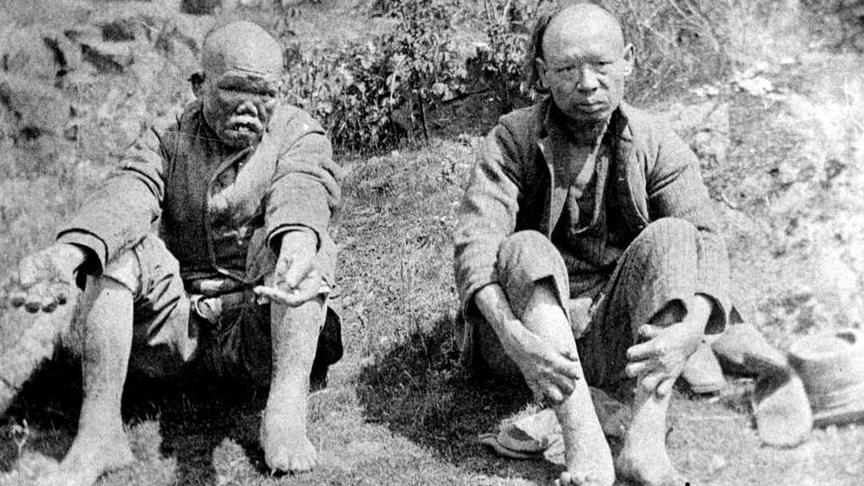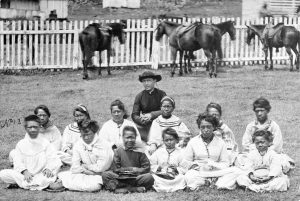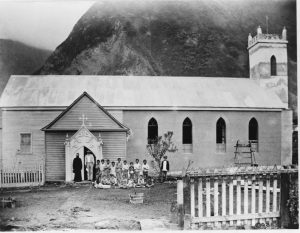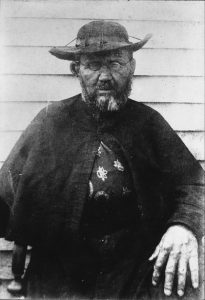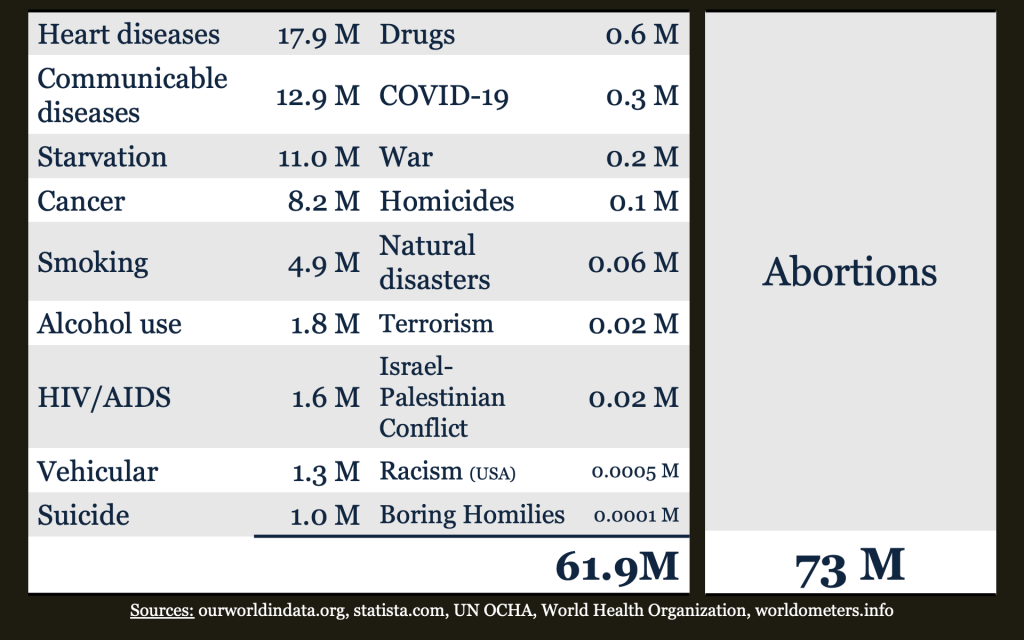Today is the final homily of our four-part pro-life series. Let’s begin with good news: A woman here gave me permission to share our conversation: She revealed to me that she had had an abortion, but has experienced Jesus’ healing, and thanked me for courage in speaking about abortion and the tone of mercy. Praise God! We began with Jesus’ mercy and want to end with His mercy towards those who are marginalized. The goal today is that our hearts are touched so that we participate in our 40 Days for Life starting Thursday, February 15, 2024.
As mentioned in the past three weeks, at the end of today’s homily, we’re going to show one video and three pictures of abortion, as we have for the past three years, so that the truth is known. I’ll give you another warning just before we show them so that no one is surprised and especially if you don’t want your children to see it.
You might remember this 2013 encounter of Pope Francis with Vinicio Riva, who has neurofibromatosis type 1:
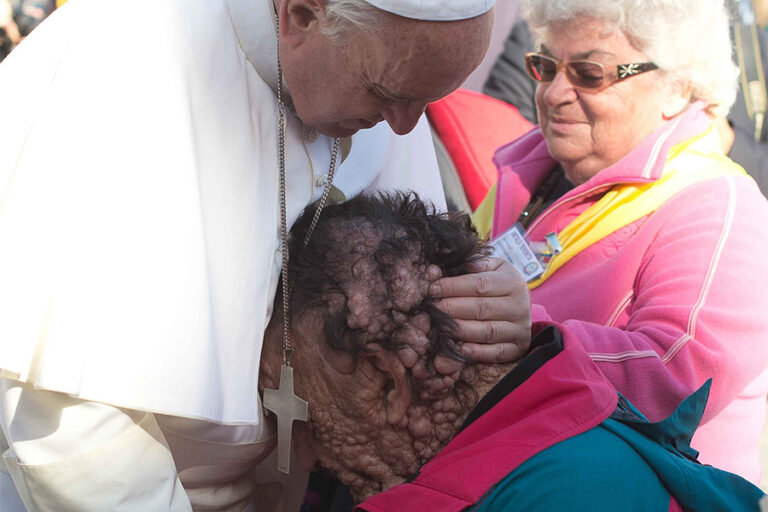
Pope Francis embraces Vincenzo Riva, a man with neurofibromatosis, at the end of his weekly general audience in this file photo from Nov. 6, 2013. (CNS photo/Vatican Media)
While most of us would pull away from someone that disfigured, the Holy Father reached out and touched him. Later, Riva said, “He didn’t think about whether to hug me or not. I’m not contagious, but he didn’t know.”
Let’s now ponder how Jesus reaches out to a man with leprosy. “A man with leprosy came to Jesus begging him, and kneeling said to Jesus, ‘If you choose, you can make me clean’” (Mk 1:40). Leprosy is a terrible disease that can disfigure people horribly, and, back then, there was no cure.
This is why the First Reading tells people who have it to separate themselves to prevent spreading the disease: “Anyone who has the leprous disease shall wear torn clothes and let the hair of their head be dishevelled and shall cover their upper lip and cry out, ‘Unclean, unclean…’ Such a one shall live alone with their dwelling outside the camp” (Lev 13:45-46). Preborn babies are also marginalized, in the sense that we avoid them, and perhaps women who have had abortions, because there’s a pain that’s not easily brought up.
By ‘coming to Jesus,’ the man shows hope. He violates the Old Testament law because he must have heard about Jesus’ miraculous power. ‘Kneeling’ is an act of desperation, and, ‘If you choose’ means he believes that Jesus has the power to cure him. And, what does he ask? Not to be healed, but to be made ‘clean.’ He wants to be ritually purified so that he can join his Jewish people in worship. It’s like a Catholic who has COVID who just wants to be healed so that they can come to Mass.
“Moved with pity, Jesus stretched out his hand and touched him, and said to him, ‘I do choose. Be made clean!’ Immediately the leprosy left him, and he was made clean” (1:41-42). Seeing the pain, Jesus has compassion and touches the man. Normally, a person would risk being infected, but Jesus uses His divine power to overcome the disease.
“Jesus sent him away at once, saying to him, ‘See that you say nothing to anyone…’ But the man went out and began to proclaim it freely… so that Jesus could no longer go into a town openly, but stayed out in the country” (1:43-45). Jesus doesn’t want the man to publicize the healing, otherwise people will get the wrong idea: They’ll think Jesus came to be their political leader. But the man tells everyone and now who’s the outcast? Jesus! He can no longer enter any town. Symbolically, Jesus took that man’s marginalization onto Himself.
Sometimes, God calls us to do this. To overcome evil, we have to take other people’s suffering onto ourselves. People choose abortion because it’s the easier choice. To help them, we need to assume some of their hardship either by supporting them, or telling them that this isn’t right, or by being insulted. This is why 40 Days for Life is powerful, because we put ourselves in a position where we could be mocked, as Jesus was.
Many of us know this saint, Damien de Veuster. Born in Belgium in 1840, he offered to be sent to the missions in Hawaii, to work on a cruise ship. Just kidding. At the age of 24, he arrived in Honolulu and was ordained five months later. 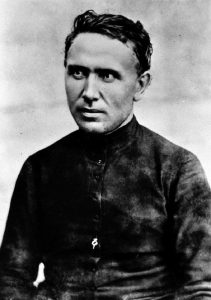 Nine years after that, he offered to go to the island of Molokai to work with around 800 people with leprosy. Damien wrote that he saw in each of them “a soul redeemed by the adorable blood of our divine Saviour…” If I cannot cure them as he did, at least I can comfort them and through the holy ministry that he… has given me, I hope that many of them, cured from leprosy of the soul, will go before his tribunal able to enter the society of the blessed,” and he wrote something similar to what we’re discussing today, “I make myself a leper with the lepers, to gain all to Jesus Christ” (Butlers Lives of the Saints, April 15, 106). He gave them the Sacraments, helped repair their homes, fundraised for them, and advocated that they be given better medicine.
Nine years after that, he offered to go to the island of Molokai to work with around 800 people with leprosy. Damien wrote that he saw in each of them “a soul redeemed by the adorable blood of our divine Saviour…” If I cannot cure them as he did, at least I can comfort them and through the holy ministry that he… has given me, I hope that many of them, cured from leprosy of the soul, will go before his tribunal able to enter the society of the blessed,” and he wrote something similar to what we’re discussing today, “I make myself a leper with the lepers, to gain all to Jesus Christ” (Butlers Lives of the Saints, April 15, 106). He gave them the Sacraments, helped repair their homes, fundraised for them, and advocated that they be given better medicine.
12 years later, he himself contracted leprosy. He went through a period of desolation and became more isolated as people began to avoid him.
Ten months later, however, God helped him overcome the desolation, and he wrote, “The good God knows what is best for my sanctification and every day I say an honest ‘fiat voluntas tua’ [Thy will be done].” Two years later, amazingly, he wrote that he was the “happiest missionary in the world,” and then more people came to join him in the mission, and he died in 1889 at the age of 49.
In a few minutes, we’re going to show the abortion imagery, and so, if you don’t want to see it, please close your eyes or look down. And, if you don’t want your children to see it, have them do the same, please. Not only are these images disturbing and heartbreaking, but the fact that they happen so often here in Vancouver is shocking. But a study by Dr. Jacqueline Harvey reported “with upwards of 90% of people responding that seeing these images increased their negative feelings toward abortion”.
Abortion is the number one cause of death in the world by far. However, if I ask: What are the greatest causes of death in our world today, what would you say? Let’s see if I have it on our list. On the left side here are the number of deaths according to cause. Now let’s see the number for abortion. These numbers are not from pro-life sources. If racism caused these many deaths, that would become the number one social justice issue. This is why the visuals of abortion must be made known because it’s hurting so many.
So, now, we’re going to show a three-minute video describing abortion. Please don’t look if you don’t want to see it.
And now, here are three real and very graphic photographs of the remains of children from abortion. It’s terrible that the law and most people support this:
- 10 weeks old
- 11 weeks old
- 22 weeks old
With Lent starting Wednesday, we have a duty to do penance for our sins and an opportunity to do acts of love to make up for the past. 40 Days for Life combines prayer, self-denial, and almsgiving into one great Lenten act of love.
This is our way of reaching out to the marginalized. If this is your first time participating, and there’s that natural human hesitation about being mocked, just ask Liera to put you in a big group, so that you’re supported. Thank you to everyone who has signed up! You’re amazing! The cards again are in the pews and this is our final weekend to sign up. Thank you!
We finish with a five-minute video about healing from abortion:
This is the grace of God we want to offer to all people. Sylvia mentioned post-abortion healing, and one of the best is Rachel’s Vineyard, which holds weekend retreats. I was blessed to participate in one before so I can testify to how beautiful it is.
It’s all about Jesus’ mercy: He offers us mercy , and so we offer it to mothers and preborn children.


